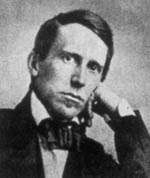Morrison Foster
Morrison Foster (June 10, 1823 – May 14, 1904) was the older brother, business agent and biographer for Stephen Foster, a composer and lyricist of early American music. When Stephen Foster died at age 37, Morrison continued to manage Stephen's estate and acted as a mediator between music publishers and Stephen Foster's wife and daughter. Documents demonstrate his correspondence with publishers in his receipt of royalty payments on behalf of Stephen's heirs.[1] Morrison also wrote the first biography of Stephen Foster. Morrison's daughter Evelyn Foster Morneweck, wrote a biography about her uncle, Chronicles of Stephen Foster's Family.[2]
Morrison Foster | |
|---|---|
| Born | June 10, 1823 |
| Died | May 14, 1904 (aged 80) Grove City, Mercer County, Pennsylvania, US |
| Occupation | Agent for Stephen Foster, Businessman |
| Home town | Pittsburgh, Pennsylvania, US |
| Spouse(s) | Jessie Lightner Foster (unknown-1882), Rebecca Shields Snowden Foster (1847 - 1929) |
| Children | 3 |
| Parent(s) | William Barclay Foster (1779–1855), Eliza Clayland Tomlinson Foster (1788–1855) |
Writings

In some instances, Morrison's biography conflicts with primary sources and other biographies on the life of his brother, Stephen Foster. He was selective in keeping records and correspondence that belonged to his brother, discarding items that he thought embarrassing. In his biography of Stephen he created an image of a dreamer, a naturally gifted musician, and a genius of a songwriter. He also wrote that Stephen was a devoted son to his parents. He portrayed his brother as being careless with his finances. Later biographies conflict with that of Morrison.[3]
Civic activity
Morrison Foster served on the Allegheny County Centennial Committee as Chairman in 1887.[4]
Archives
Archival documents authored by Morrison Foster are housed with the Archives Service Center, University Library System, University of Pittsburgh. Digital copies of these documents are accessible online at high resolutions and are in the public domain. Online access does not require a subscription and physical access can be scheduled for research purposes to view and examine the documents and other items in the collection.[3]
References
- Root, Deane L. (March 12, 1990). "The "Mythology " of Stephen C. Foster or Why His True Story Remains Untold". American Music Research Center Journal (Lecture transcript at the American Music Center Research Conference)
|format=requires|url=(help): 20–36. - Howard, John Tasker (1944). "The Literature on Stephen Foster". Notes. 1 (2): 10–15. doi:10.2307/891301. ISSN 0027-4380. JSTOR 891301.
- "Foster Hall Collection, Collection Number: CAM.FHC.2011.01, Guide to Archives and Manuscript Collections at the University of Pittsburgh Library System". University of Pittsburgh, Center for American Music. Retrieved October 13, 2015.
- Allegheny County: its early history and subsequent development: from the earliest period till 1790 / by A. A. Lambing ; from 1790 till the present time / by J. W. F. White ; published under the auspices of the Allegheny County Centennial Committee. Authors: Allegheny County Centennial Committee (Pa.), Lambing, Andrew Arnold, 1842-1918, White, J.W.F. (John William Fletcher), 1821-1900, McCain, George Nox, 1856-1934. Collection: Historic Pittsburgh Text Collection
